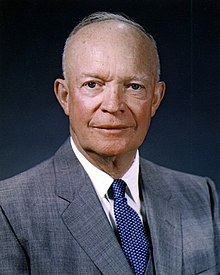Eisenhower Doctrine

The Eisenhower Doctrine is an authorization issued on January 5, 1957 by then US President Dwight D. Eisenhower . It said that the USA would protect pro-Western regimes from communist infiltration or a threat from the Soviet Union everywhere and with all available means (including the use of nuclear weapons).
The doctrine was formulated in response to the Suez crisis , which had led to an end to Western dominance in the Arab world. Arab nationalism was out for the independence and sovereignty of the Arab states, which the USA equated with communist tendencies.
The USA applied the Eisenhower Doctrine twice: In April 1957, a US fleet supported the Jordanian King Hussein I when the latter launched a coup against his own government to prevent Jordan from rapprochement with the Soviet Union. In the Lebanon crisis (July to September 1958), US troops came to the aid of the Christian President Camille Chamoun , who wanted the United Arab Republic to incorporate what was then the only pluralistic democracy in the Arab world , which had already united Syria and Egypt under Nasser's leadership , wanted to prevent by Muslim insurgents in Lebanon.
Nasser's popularity in the Arab world and the merger of Syria and Egypt to form the United Arab Republic in 1958 marked a setback for Eisenhower's policy in the Middle East. The intervention of the USA in the politics of the region also triggered a rejection of the United States in the Arab population.
When Soviet Prime Minister Nikita Sergejewitsch Khrushchev visited the USA in September 1959, he and Eisenhower switched to a coexistence course between the two power blocs. In the same year the Eisenhower Doctrine was formally abandoned.
literature
- Heiko Meiertöns: The doctrines of US security policy - evaluation of international law and its influence on international law. Nomos, Baden-Baden 2006, ISBN 978-3-8329-1904-7 (= international law and foreign policy , volume 71, also a dissertation at the University of Munich 2005; awarded the Helmuth James von Moltke Prize of the German Society for Defense law and international humanitarian law).